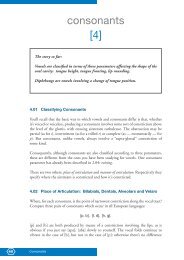PHONETICS MANUAL.indd - HumBox
PHONETICS MANUAL.indd - HumBox
PHONETICS MANUAL.indd - HumBox
Create successful ePaper yourself
Turn your PDF publications into a flip-book with our unique Google optimized e-Paper software.
(1) the velum is raised (as it is for all consonants except nasals)<br />
(2) the vocal folds are vibrating<br />
(3) the blade of the tongue is closed tightly against the alveolum (or occasionally<br />
the front of the tongue against the hard palate)<br />
(4) the side of the tongue is grooved, so that the air leaves through the corner of<br />
the mouth.<br />
Condition 3 means that the point of articulation is alveolar (or palatal). But, uniquely<br />
among consonants, the air escapes “along the side” (condition 4), so the manner of<br />
articulation is said to be LATERAL.<br />
Whether the air flows out through the right-hand corner of the lips or the left-hand<br />
corner, or even through both corners (i.e. with a groove on either side of the tongue)<br />
is something that varies from one individual to another, irrespective of the language<br />
being spoken. So you can carry on using whichever side you’re used to. (Indeed it’s<br />
quite difficult to produce a lateral using the opposite side!)<br />
Laterals are usually alveolar, but Hispanists will have met a palatal lateral in words like<br />
llama or calle. The IPA symbol is [˘], and, as the tongue position is similar to that for<br />
the high front semi-vowel [j], the effect is not unlike that of [lj] in English value. In<br />
fact there is a strong tendency in Spanish to replace [˘] by [j] altogether, so that pollo<br />
(“chicken”) and poyo (“bench”) fall together as [pojo] — or even as [poZo] (see 4.05).<br />
Few speakers of English are aware of it, but there are actually two variants of [l]<br />
in most English accents (including RP and American and Australian varieties). At<br />
the end of a word or before a consonant (well, child), the [l], in addition to having<br />
the features listed above, is pronounced with the back of the tongue raised slightly<br />
towards the soft palate. But this doesn’t apply at the beginning of a word or after a<br />
consonant, e.g. in like or play. It’s not easy to sense these tongue positions, but the<br />
difference between the “dark” [] of well and the “clear” [l] of play shouldn’t be to<br />
difficult to hear, particularly if you try to interchange them, i.e. to say well with the<br />
[l] of play, and vice versa.<br />
The technical term for “dark” [] is “velarized [l]”. When it’s important to register<br />
the distinction, the IPA uses [l] for the clear variety and [] (“l tilde”) for the dark<br />
~<br />
variety. But in ordinary transcription of English, [l] can be used for both clear and<br />
dark versions.<br />
This alternation between two types of [l] is a feature of English which is not shared by<br />
standard French, German, Spanish or Italian. In each of these languages, [l] is always<br />
clear and dark [] is unknown. For example the French word belle doesn’t sound like<br />
the English bell as far as its final consonant is concerned. Similarly for German (voll,<br />
etc.) and Spanish (arból, etc.). Using dark [] in these languages is a typical and all too<br />
conspicuous feature of a British accent. (However, in languages like Dutch, Portuguese<br />
or Russian, both types of [l] do occur, as in English, though they may be distributed<br />
differently.)<br />
58 Consonants






